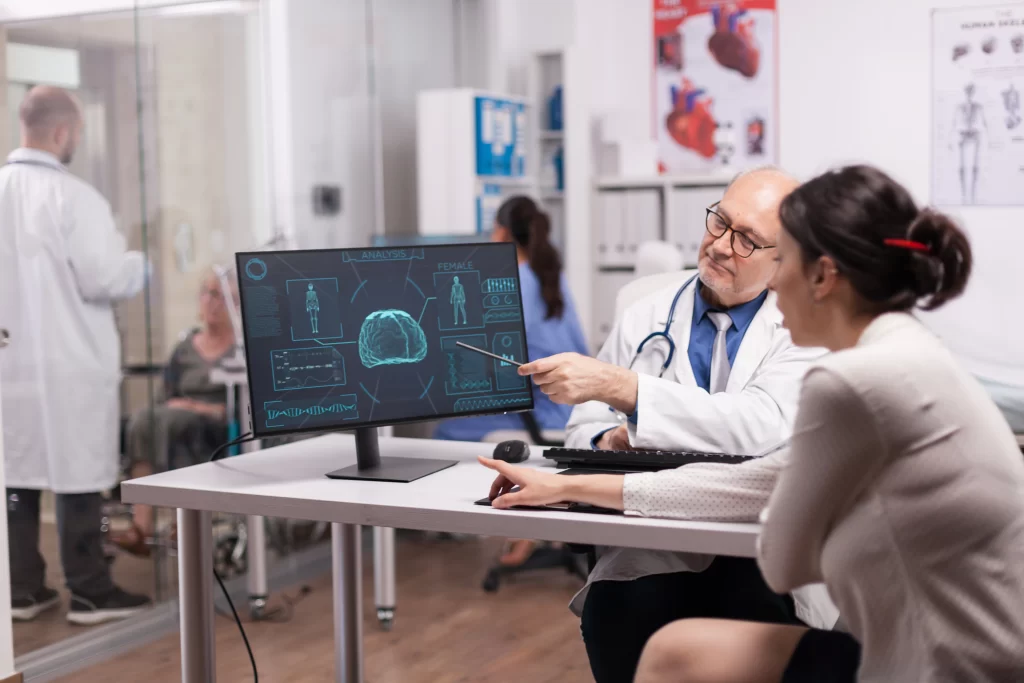What Is a Frontal Lobe Seizure?
A frontal lobe seizure occurs in the frontal part of the brain, behind the forehead, affecting several important neurological centres. Frontal lobe seizures are a form of epilepsy in which a cluster of neurons located in the frontal lobes sends irregular signals that turn into a seizure.
Possible causes of frontal lobe seizures include:
- Tumours
- Differences in brain development
- Traumatic brain injury
- Stroke
- Severe brain infections
The frontal lobes form the largest area of the brain and are the most susceptible to traumatic brain injury. Frontal lobes control a range of essential functions in the body, including:
- Voluntary movements
- Memory
- Impulse control
- Problem-solving skills
- Language skills
- Judgement and reasoning
- Social and instinctive behaviour
Unlike other epileptic seizures, frontal lobe episodes present symptoms that can be mistaken for behaviour problems or sleep disorders, like unusual movements, and symptoms can occur during sleep.
What Is Nocturnal Frontal Lobe Epilepsy?
Frontal lobe seizures can occur when a person is awake or asleep, although numbers show they are more frequent at night.
Nocturnal frontal lobe epilepsy (NFLE) is diagnosed when people experience frontal lobe seizures only in their sleep. They can appear with the following symptoms:
- Sudden wake-ups for no apparent reason
- Night-wetting
- Shivering
- Uncontrolled shouting or screaming
- Jerking movements of the arms and legs
An accurate assessment is essential in managing seizures effectively and preventing possible risks and complications.
Who Can Get Frontal Lobe Seizures?
Frontal lobe seizures can affect people of any age and gender. Some risk factors are common with those of epilepsy, including:
- Congenital brain-developmental differences
- Severe brain infections
- Early childhood epilepsy
- Stroke
- Traumatic Brain Injury
- Tumours

How Common Is Frontal Lobe Epilepsy?
Frontal lobe epilepsy (FLE) is estimated in 20-30% of partial seizures in the UK, and it’s the second most common type of focal epilepsy.
What Causes Frontal Lobe Epilepsy?
Almost half of frontal lobe seizures are caused by a difference in brain development during pregnancy. The variation occurs in the brain’s outer layer (cerebral cortex) or cerebrum responsible for higher processes, including consciousness, memory and reasoning. The underlying reason for this alteration in brain development is unknown.
Other possible causes of frontal lobe epilepsy include damage of the frontal lobe region caused by mechanical trauma, stroke or abnormal growth of tumour brain cells.
Nocturnal frontal lobe epilepsy is associated with genetic mutations and appears to run in families. This form of epilepsy is called autosomal dominant nocturnal frontal lobe epilepsy (ADNFLE) and is very infrequent.
Symptoms of Frontal Lobe Epilepsy?
Seizures in frontal lobe epilepsy typically last a short time (up to 30 seconds) and can appear in repeating clusters. Some people may lose awareness during frontal lobe seizure, whilst others may not.
Many individuals experience warning signs of a seizure, known as the “aura”, that often includes:
- Feeling dizzy or lightheaded
- Loss of balance
- Tingling and numbness throughout the body
- Panic attack or fear
- Hallucinations
In many cases, frontal lobe seizures appear during sleep or when the person is awake, and the person may experience the following signs of seizures:
- Unusual behaviour, such as uncontrolled screaming, crying or laughing
- Sleep-walking
- Twitching or jerking with the arms and legs
- Uncontrolled blinking or chewing motions
- Repetitive movements
- Involuntary eye movements to one side
- Thrashing or struggling movements with arms and legs
- Bedwetting
Following a frontal lobe seizure, people may experience temporary memory loss and feel confused or exhausted.


Complications of Frontal Lobe Seizures
As many frontal lobe seizures occur while the person is asleep, there are potential risks caused by the seizures and complications that include:
- Injuries: Some people may have bruises, fractures, cuts or other injuries during a seizure
- Status epilepticus: If a person having a seizure doesn’t regain consciousness within five minutes or longer, it requires urgent medical help. This is called status epilepticus, and it’s a life-threatening health condition
- Sudden unexplained death in epilepsy (SUDEP): This is a sudden and unexpected outcome of an epileptic seizure. About 1 in 1,000 people with epilepsy have a SUDEP with no clear cause
- Anxiety and depression: People with epilepsy are susceptible to developing anxiety disorders and even depression. Frontal lobe epilepsy in children is associated with a higher chance of having attention deficit hyperactivity disorder (ADHD)
Frontal Lobe Epilepsy Diagnosis
As indicated earlier in the text, diagnosing frontal lobe epilepsy may be difficult because, at first, the seizure symptoms may resemble behaviour that challenges or sleep terrors. Sometimes the effects of frontal lobe seizures might be caused by a seizure that started in other brain areas.
Your GP will ask for a medical history and general health information to diagnose frontal lobe seizures. Then, they may ask you to do all the necessary analysis, including neurological tests and physical examinations such as:
- Hearing and speech
- Vision
- Sensory and cognitive skills
- Muscle strength
- Balance and coordination
Common methods used in diagnosing frontal lobe epilepsy include:
- Electroencephalography (EEG) – measures the electrical activity in your brain with the help of electrodes attached to your scalp
- MRI – helps identify any changes in the brain structure, such as lesions, scars or tumours, that might be the root cause of a seizure
- Stereoelectroencephalography (SEEG) – a minimally invasive surgical process in which your doctor will implant electrodes in the brain to accurately identify the source of the seizure. SEEG is used to locate the seizure activity that cannot be detected with EEG
- Video EEG – helps monitor your behaviour and movements and your brain activity. EEG observation may be held in a hospital where you can stay overnight or undergo a sleep study, as most frontal lobe seizures occur while the person is asleep
Treatment Options
There are several treatment methods for addressing frontal lobe seizures. The most common include:
- Medication
- Diet plans and lifestyle
- Neuromodulation
- Surgical procedure
Medications in the Treatment of Frontal Lobe Seizures
In most cases, your healthcare provider will prescribe anti-seizure medications depending on epilepsy. Anti-epileptic drugs help regulate the electrical activity in the brain, preventing seizures from happening or reducing the frequency. For people with epilepsy who don’t find these medications effective, doctors may recommend other alternative treatments, such as neuromodulation or surgical intervention.
Diet Plans and Lifestyle in the Treatment of Frontal Lobe Seizures
Many healthcare practitioners recommend special diets and lifestyle changes to prevent frontal lobe seizures. Experts suggest that ketogenic nutrition, or a low-carbohydrate and high-fat diet, can reduce the chances of having a seizure by 50%. This is especially beneficial for children with epilepsy. In addition, reducing stress and getting enough sleep is crucial in preventing epileptic seizures.
Surgery in the Treatment of Frontal Lobe Seizures
People with frontal lobe epilepsy who don’t respond well to anti-epileptic medications may decide to undergo a surgical treatment. The process is thorough and goes step by step, from complete medical history to EEG video observation. With epilepsy surgery, medical professionals will remove the part of the frontal lobe that is causing seizures.
Neuromodulation in the Treatment of Frontal Lobe Seizures
Neuromodulation is a modification of the nerve activity in the brain by delivering electrical stimulation to specifically targeted parts of the brain. It is performed by implanting devices that act as pacemakers and serve to normalise or modulate the function in the specific brain area responsible for causing a seizure.
How to Prevent Seizures While Sleeping
Whilst you cannot predict or prevent a seizure from happening, there are several things you can do to reduce the possibility of having a seizure while sleeping. Implementing some of the following points in our checklist has shown outstanding results in the people with epilepsy that we support.
As a healthcare provider, Unique Community Services are here to help you maintain a healthy lifestyle and follow the best daily routines to prevent seizures while sleeping, including:
- Regular medication therapy
- Healthy diet and physical activity
- Relieve stress and everyday tension
- Relieve the fear form having a seizure
- Avoid alcohol or other substances that cause seizures
- Get enough sleep and maintain regular sleeping patterns
- Avoid bright and flashing lights and noise
- Practice yoga or breathing exercises
At Unique Community Services, we support and encourage people to care for their physical and mental health and well-being. We are here to control and prevent all the possible seizure-associated triggers and ensure that you feel safe and live your life to the fullest potential.


Support for Frontal Lobe Epilepsy with Unique Community Services
At Unique Community Services, we support people with a range of complex care needs, including epilepsy, physical disabilities and people with acquired brain injury. Our services and support are rooted in a person-centred and humanised approach that is implemented in every action we take.
Our clinicians provide unique and consistent support, from several-hour shifts to 24/7 care at home. We create solid relationships with the people we serve and their families. Together, we build a single system of integrated care and support.
If you need personal care assistance, overnight care or live-in home care, we are here to meet all your needs and foster your journey towards independence and meaningful life. Contact us today at our two offices in Leeds and Manchester.




